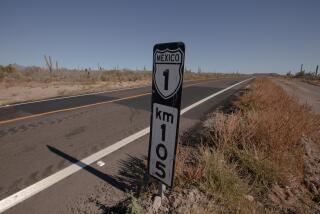Countries where dollars go the distance
Longing for an out-of-country excursion but feeling a little poor because you have only dollars in your pocket? Relax. Even with the fast-eroding value of the dollar against other currencies, you still can find international destinations where your buck goes a long way.
And you won’t have to forgo choice sightseeing or comfort. All you need is a little latitude -- and longitude -- in selecting your next vacation spot.
Last year I wanted to take one long trip before I had to ease into professional life. Like many new college grads, I had little money. And even though I’m an Anglophile, the exchange rate ($1.88 to the pound in May 2006, when I traveled), would have pummeled my savings. (The rate is even worse these days: $2.06 to the pound.) Besides, my checking account still harbored a painful dent from two months I spent in London two summers ago.
I hadn’t seen enough of mainland Europe either, but I couldn’t deal with the drooping dollar. I needed a destination where I could spend a month comfortably for less than $2,000.
On the recommendation of a friend, I went to Vietnam, a country where I spent the first three years of my life but that I regarded with caution because it is developing and off most Western travelers’ radar.
But at the end of my five weeks there, I didn’t want to leave. It was the best vacation I’ve had -- and the most cost-efficient too.
On average, I spent $30 a day (or less) there, and I wasn’t living like a backpacker. In Hanoi, Vietnam’s capital, my room at the centrally located Asia Hotel had a private bathroom, air-conditioning, cable TV and maid service -- for $12 a night. I spent $3 or $4 on nice dinners. I walked out of one restaurant because the entrees were more than $5.
Entertainment was inexpensive too. At Nha Trang, a beautiful coastal city in southern Vietnam, I went on a half-day cruise for about $10. Our boat made several stops and included a tasty lunch.
Access to many of Vietnam’s most alluring locales, such as its pristine beaches and Halong Bay, a UNESCO World Heritage site, is free.
Though Vietnam remains a poor country, it is fairly safe and its people are friendly. Taxi drivers and shopkeepers may overcharge you, but those are the chief nuisances you’ll encounter.
Travelers will find other nations that offer adventure and world-class sightseeing on a budget, though some may be undeveloped and lack the extensive tourist infrastructure of more modern nations. Explore and stay within budget, but not at the risk of your safety. Careful research and planning should help you craft a safe, memorable trip. Check the U.S. State Department, www.travel.state.gov, for travel advisories before you go. Read the department’s consular information sheets.
Here are five countries where tourism has yet to reach critical mass but where travelers will feel safe and find their trip well worthwhile.
Morocco
Bordering the Atlantic Ocean and Mediterranean Sea in northern Africa, Morocco has an eclectic identity that has been shaped by its location and long history. This Arab nation has many European influences because it’s so close to the Continent. Arabic is the official language, but French is spoken widely. Though it’s a developing nation, Morocco has easily accessible transportation and a range of lodging and eating options to fit many budgets. With a dollar worth almost 8 Moroccan dirhams, you can easily buy meals for less than $5. Many cafes offer breakfast for about a buck.
In Tangier, you can stay at the Hotel El Muniria, whose former guests include Beat writers Allen Ginsburg and Jack Kerouac. A room for two there goes for less than $30 a night. You’ll find comparable rates throughout the country, though the accommodations may be modest.
While in Morocco, visit one of the omnipresent markets or bazaars that often serve as hubs for everyday life. Morocco’s rugged yet scenic landscape has made it an increasingly popular destination for adventurer travelers. You can hike the High Atlas Mountains or tour the starkly beautiful dunes at the start of the Sahara.
In Africa, Dave Herbert, managing director and founder of the tour company African Travel Inc., recommends traveling in groups.
If you want to travel independently, “Go on a tour and stay a week on your own,” says Sylvia Frommer-Mracky, owner of Production Travel and Tours, based in Glendale.
BOLIVIA
Landlocked with many areas at high altitudes, Bolivia is often called the Tibet of the Americas, and like its counterpart in Asia, it’s one of the poorest countries in South America. But Bolivia is relatively peaceful and offers basic facilities for travelers, such as lodging and transportation.
“Foreigners can generally walk the streets in most areas of Bolivia’s major cities without the fear of becoming a victim of violence, if they observe reasonable precautions,” the Overseas Security Advisory Council, a federal advisory committee, notes. Air travel around the country is economical and meets International Civil Aviation Organization safety standards.
Largely undiscovered by tourists outside of South America, Bolivia is a feast for the adventurous spirit as well as a respite for the embattled wallet. In the last 10 years, the dollar has increased in value almost 45% against the boliviano.
With the favorable exchange rate, you can find single rooms with private baths for less than $10 a night at budget hotels or stay at top-tier hotels for less than $100 a night. The Hotel Radisson Plaza in La Paz, considered an upper category hotel, has single-occupancy rooms starting at $99 a night during the high season from June to September (winter there). In London, you’ll be lucky to get a private hostel room for that.
For its low prices, Bolivia has much to offer. Culture, from ancient ruins to a thriving indigenous population, permeates a country that was a part of the mighty Incan empire. Bolivia is also home to the lush Amazon rain forests as well as the snow-capped Andes.
CAMBODIA
After decades of unrest, stability gradually has returned to Cambodia after democratic elections in 1993. Though still a poor country, it is largely peaceful like its Southeast Asian neighbor, Vietnam. Underdeveloped Cambodia -- 66% of its land is forests and woodland -- attracts adventurers. The prices are similar to those you’ll find in Vietnam, even a little cheaper.
Modest meals cost about $2 to $3. Fancier meals are about $10. Expect to pay around $10 a night for a decent room, though cheaper accommodations are available. Upscale hotels cost about $50 a night. (Riels are the official currency of Cambodia, but dollars are readily accepted, so you won’t have to worry about doing long division in your head.)
Its intricate temples are awe-inspiring. The most famous are the Angkor ruins, the pinnacle of Khmer architecture.
NICARAGUA
Though tourism is increasing in Nicaragua, it doesn’t attract as many tourists as its more popular neighbors in Central America, such as Costa Rica. The civil war ended nearly two decades ago, and “Nicaragua has become a safer destination than it was 10 years ago,” says Alicia Zablocki, director of Latin American programs at Mountain Travel Sobek.
Travelers will find the country peaceful and affordable. You can get a meal of tamales or empanadas from street vendors for a buck or two, though higher-end and more expensive international fare is available in larger cities. Budget lodging goes for about $5 a night on the low end, but expect to pay more if you want features such as a private bathroom. Luxury hotels in major cities charge a fraction of the price in more popular Central American destinations.
Nicaragua’s natural features are its chief assets. Large tracts of rain forest and accessible volcanoes make for breathtaking wilderness excursions.
Albania
Albania, in southeast Europe, is one of the Continent’s poorest countries. Isolated and communist into the 1990s, Albania is on its way to becoming a free market economy. The State Department classifies Albania as a “high” crime country, but it notes that crime against foreigners is “rare as it is viewed as too risky.” Albanians generally have a favorable view of Americans, so there’s no need to wear your “I Love New York” shirts inside out.
Albania is not yet a member of the European Union, and its currency, the lek, is low against the dollar. You can find meals for less than $5, fancier fare for less than $20. Stay in dormitory-style hostels for about $20 a night.
Ruled by empires including the Roman, Byzantine and Ottoman, Albania is rich in archaeological sites. Ruins from each of the civilizations can still be found in cities across the country, particularly in Apollonia, an important settlement of the Greeks. Berat, a well-preserved ancient city, boasts a medieval fortress and beautiful churches.
Other budget moves
Some popular destinations also offer great deals. Go to Baja California, recommends Ron Archer, co-owner and vice president of Archer Travel Service. It’s a convenient and inexpensive trip for Southern Californians, and Baja offers scenic views and reasonable prices.
Packages, which help you lock in prices, are also a good way to save money, even to cost-efficient destinations. Travel companies are often able to leverage their relationships with hotels and airlines to get you better rates. As the euro and pound creep ever higher, travelers will continue to look to other destinations to find affordable vacations. Destinations like the Caribbean, Latin American and parts of Asia have already increased in popularity from last year. “Undiscovered” destinations will eventually be found, because tourism is an inescapable force. Take the opportunity to explore off-the-beaten path while you still have the chance and bargains can still be found.
More to Read
Sign up for The Wild
We’ll help you find the best places to hike, bike and run, as well as the perfect silent spots for meditation and yoga.
You may occasionally receive promotional content from the Los Angeles Times.






